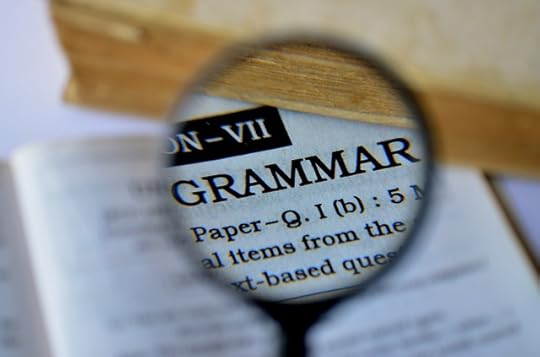Monthly gleanings for August 2019
Grammar and glamour
As is known, glamour is a spelling variant of glamor even in American English. The question I received was about the connection between glamour and grammar. The word glamour appeared in printed books only in the 18th century. It occurred in Scottish ballads and meant “magic, enchantment.” If Walter Scott had not picked it up and made famous, most of us may never have heard about its existence. (Incidentally, both English and German owe to the Romantics the revival of many obsolete and regional words.) Those who consult old dictionaries may have read that glamour goes back to Glámr, the name of the most famous Icelandic ghost (actually, revenant), described in The Saga of Grettir, or glámr, the Old Icelandic poetic name of the moon, allegedly, the chief producer of illusions. This etymology is wrong. But the true one is a bit puzzling.
 The most glamorous field of knowledge, and it is also “fun.” Image by PDPics from Pixabay.
The most glamorous field of knowledge, and it is also “fun.” Image by PDPics from Pixabay.Glamour is undoubtedly an alteration of grammar. Under the term grammar were formerly included all areas of linguistics, and later, “learning” acquired the sense “magic, enchantment.” The word that interests us has been recorded in the forms gramary, gramery; glamery, glamour, and so forth. They reached Scotland from France. The change of gr– to gl– in glamour has never been explained, and this is the puzzling element. Not inconceivably, some words like gleam and glow contributed to the change, but this is guesswork.
 This woman is always losing her keys. Photo by Susanne Nilsson. CC by-SA 2.0 via Flickr.
This woman is always losing her keys. Photo by Susanne Nilsson. CC by-SA 2.0 via Flickr.Nowadays, grammar has been all but banished from schools, because, allegedly, it provides no fun, and everything in our educational system is supposed to be fun in its most primitive form. I have taught grammar all my life and can testify to the fact that its enchantment is strong, and, once students realize the magic of cases, moods, tenses, and the rest and begin to notice the use of grammar for the niceties of style, they always ask for more. (Here is one example. Everybody knows that the progressive, or continuous, tense describes an action happening right now, for example, I am standing in front of you, as opposed to I always stand while lecturing. It is rewarding to watch the outburst of curiosity when I ask why then it is possible to say I am always losing my key.) But, of course, to be able to provide a feast, one needs a group of hungry guests.
Three words for “flat”
Those are Engl. flat and German flach and platt. Platt is the easiest to explain. It is a borrowing of a French adjective. Engl. plate, plateau, platypus (the latter a bookish formation from two Greek words), and platitude have this root, widespread in Latin and Greek. Flach is related to Latin plaga “flat surface,” which is akin to neither plague nor plagiarism. Flat is the hardest case. The first root of platypus, mentioned above, reproduces Greek platús ”broad” (compare Plato, whose name meant “broad-shouldered”). As though to tease us, the first consonants in flat ~ platús correspond nicely (Germanic f to non-Germanic p, as in Latin pater versus Engl. father), but where Greek has t, we should expect Engl. th (compare Latin trēs and Engl. three). The numerous attempts to obviate this difficulty have left the riddle unsolved. This is a parade example of how comparative phonetics works. Before the nineteenth century, platt, flat, and flach could have been compared without much trouble, but we avoid the easy solution, and with much wisdom comes much sorrow.
 The animal is broad-footed. Etymological musings play no role in its life. Heinrich Harder (1858-1935). Public domain via Wikimedia Commons.
The animal is broad-footed. Etymological musings play no role in its life. Heinrich Harder (1858-1935). Public domain via Wikimedia Commons.The origin of the word beaver
There are more than three etymologies of beaver. Some of them are old and fanciful. The one mentioned in the comment was offered by Eric Hamp (Indogermanische Forschungen 77, 1972, p. 164). The reference can be found in my Bibliography of English Etymology. Hamp believed that the reconstructed Germanic root bhebhru– must go back to a verbal root. “Is it too bold to suggest that the beaver was so called because he carried (bhher) wood to make his dam?” This conjecture has not been discussed in later works, and probably for good reason. Even though the beaver indeed carries logs, sometimes from afar, this feature does not look prominent enough for calling the animal “carrier.” (For comparison: no beast of burden has such a name.) Those who have an idea of Hamp’s output know that he has written several thousand notes. Any idea that occurred to him immediately appeared in print. Many of his notes are one paragraph long. If someone happened to point to an inconsistency in his reasoning or to a fact that contradicted his conclusion, he tended to agree with his critic. In my opinion, his etymology of beaver is one of such rather insubstantial ideas.
Sn– and sm-words
German nörgeln “to moan; cavil; grumble, schnarchen “to snore,” and many others like them certainly belong with the sn-words I have discussed in my post. Some of them begin with n, rather than sn– because of s-mobile (about which see the post for last week). German schnurz in mir ist es schnurz, a synonym of mir ist es schnuppe “I cannot care less; it is all the same to me,” is obscure, but both words are probably sound symbolic and may be vaguely connected with the concept of the nose (my subject was snuff). The long nose figures prominently as a derogatory gesture, though some gestures are unpredictable: as Ian Ritchie noted in his comment, the Italians tap the right side of the bridge of one’s nose to indicate cleverness. Also, schnurz rhymes with Furz “a fart.” As usual, when sound symbolism comes in, sound imitation (onomatopoeia) is not far behind.
 The long nose, an international gesture of opprobrious contempt. 131 Thumbing Nose, Wat Pho by Anandajoti Bhikkhu. CC-by-2.0 via Flickr.
The long nose, an international gesture of opprobrious contempt. 131 Thumbing Nose, Wat Pho by Anandajoti Bhikkhu. CC-by-2.0 via Flickr.No, I don’t think that smell is from smoke. The words are so different that neither can be the etymon of the other. At best, the same “sound-symbolic idea” unites them, and, if there is any truth in this reconstruction, “smell,” I believe, is primary.
Pig’s eye
I am grateful for both comments. I did know that pig’s eye once meant “ace” in slang, and even toyed with the idea that here we have a bridge to asshole. But of course, there is no way to substantiate such an idea. In a way, I am sorry that I rushed in where serious specialists prefer to tread gingerly. Matthew Goff asked me whether I could say something about pig’s eye in connection with the history of St. Paul, and I used my database for the answer. But my materials payed me false. I now know that the whole of St. Paul was never called Pig’s Eye and that the famous grog shop was not called that either. Mr. Goff thanks me graciously for taking up this subject, but it would have been better if I had not done so. Yet what I said about pig’s eye as a term of endearment and a flower name is correct.
American idioms
I read with great interest the comments on seven-by-nine politicians. Obviously, the phrase seven-by-nine acquired a life of its own. I have also received a letter on let George do it. My view of the origin of such idioms is rather melancholy. The choice of names in them often seems to be arbitrary. Roger, meaning “received,” and Roger in Jolly Roger could probably have been Richard (now Romeo has supplanted Roger!). And think of the countless uses of jack, jenny, and dick (the latter returns us to Richard), not to forget about peter and tom in tomcat and tomgirl.
Mangle
The post for July 24, 2019 was on the history of the word mangle. Some of our readers dealt with the mangle I described when they were young. Their experience is instructive. Justin T. Holt told an amusing story of the mangling of his German etymological dictionary. He owns the 21st edition of Kluge-Seebold. The latest is the 25th, but there is very little difference between the two. The entry on the noun Mangel provides the usual information; the verb mangeln is compared with Latin mancare, as mentioned in my post. The text is the same in all the editions.
Spelling Reform
The work on the Reform continues. Many proposals have been sifted and analyzed, and early in 2020 we may expect a second meeting of the Spelling Congress.
Feature image credit: A pirate flag by Oren neu dag. CC-BY-SA-3.0 via Wikimedia Commons.
The post Monthly gleanings for August 2019 appeared first on OUPblog.

Oxford University Press's Blog
- Oxford University Press's profile
- 238 followers



